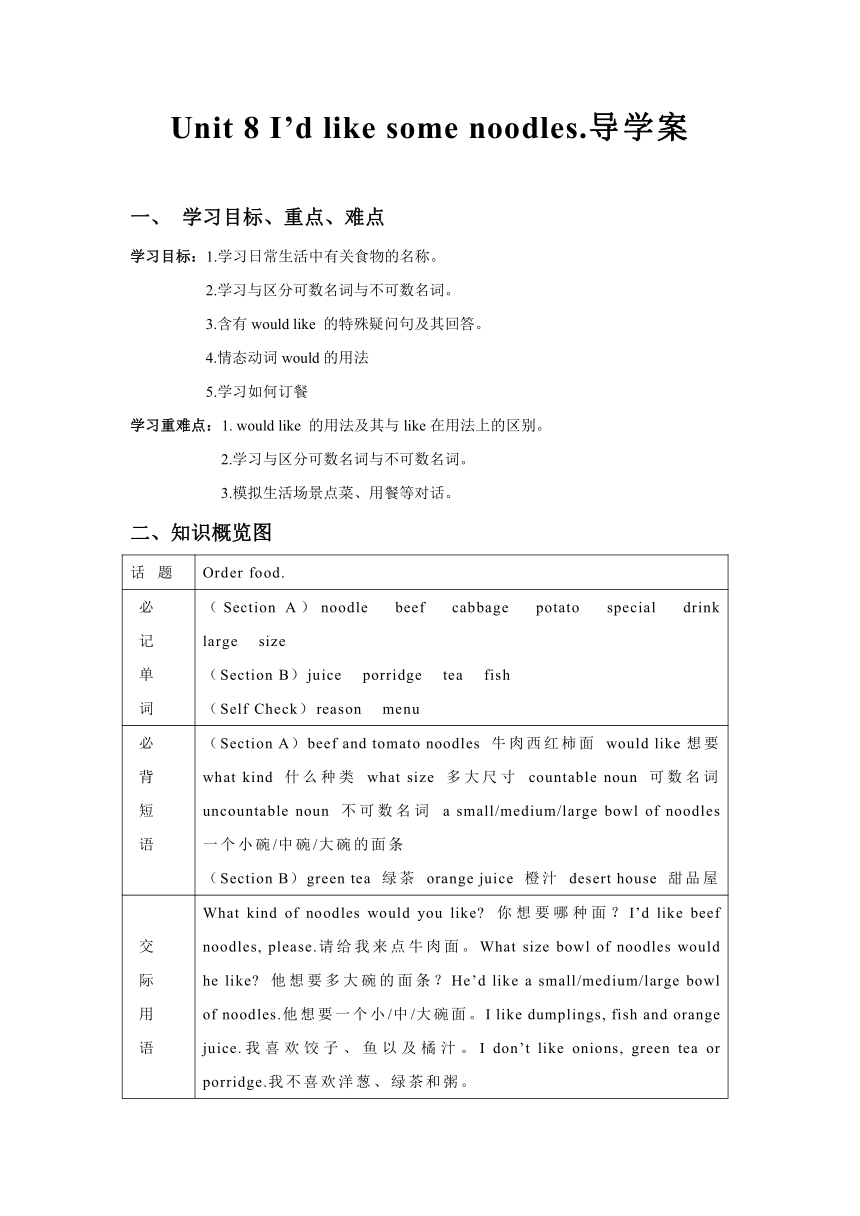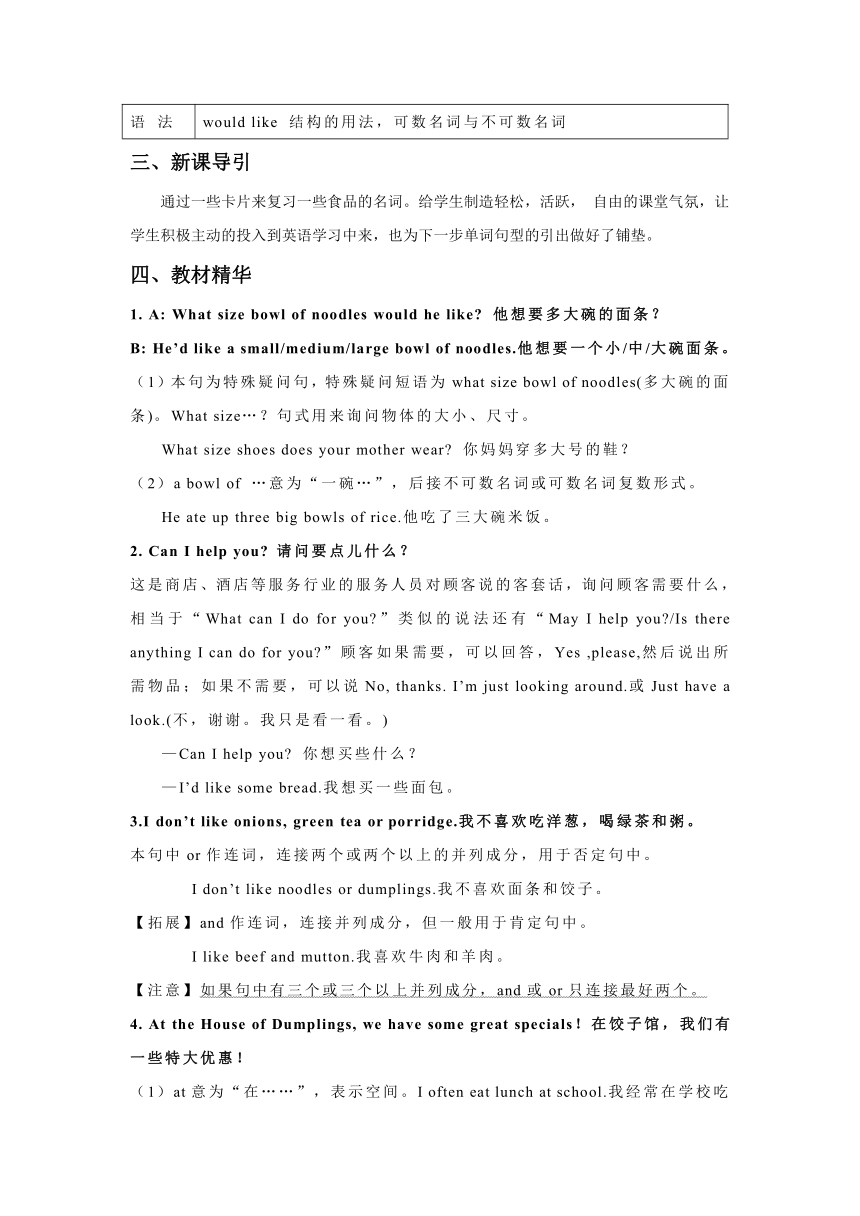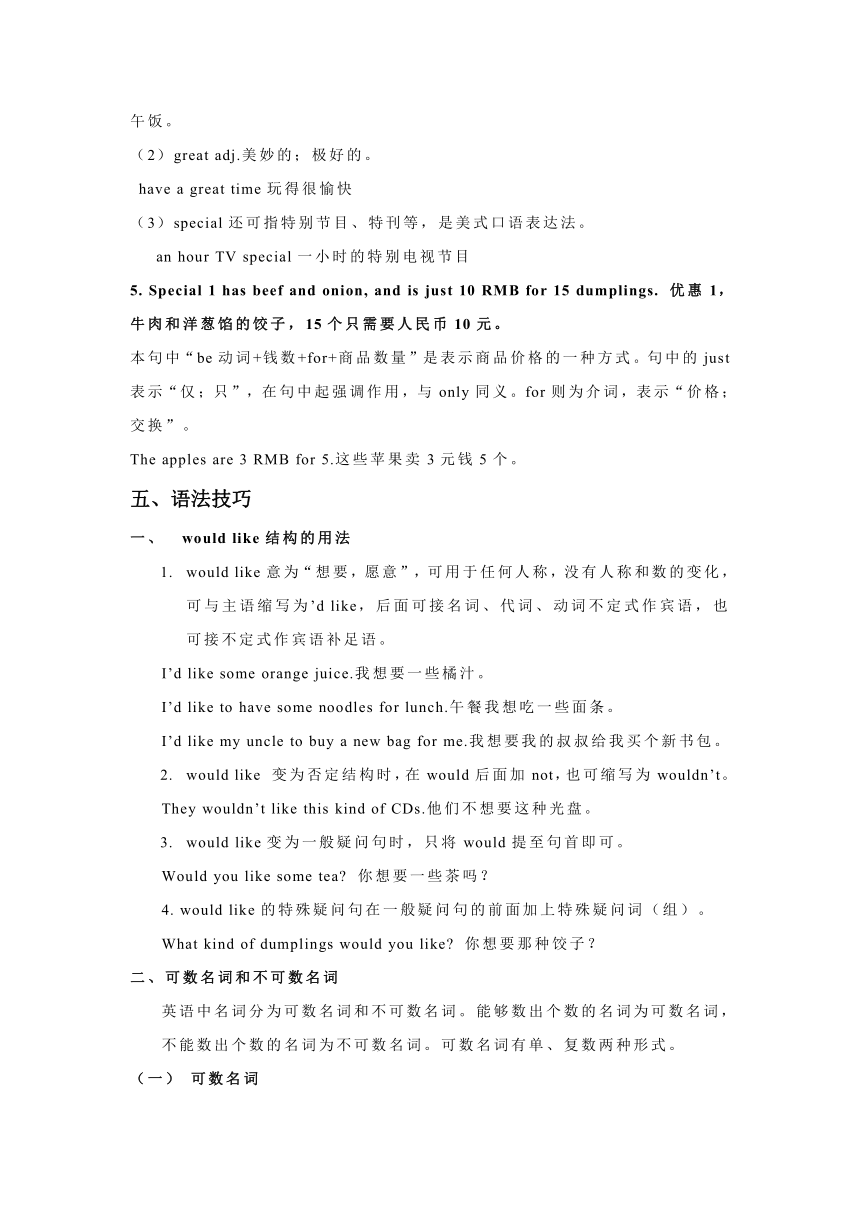Unit 8 I’d like some noodles导学案
文档属性
| 名称 | Unit 8 I’d like some noodles导学案 |  | |
| 格式 | zip | ||
| 文件大小 | 18.1KB | ||
| 资源类型 | 教案 | ||
| 版本资源 | 人教新目标(Go for it)版 | ||
| 科目 | 英语 | ||
| 更新时间 | 2012-02-14 20:48:24 | ||
图片预览



文档简介
Unit 8 I’d like some noodles.导学案
学习目标、重点、难点
学习目标:1.学习日常生活中有关食物的名称。
2.学习与区分可数名词与不可数名词。
3.含有would like 的特殊疑问句及其回答。
4.情态动词would的用法
5.学习如何订餐
学习重难点:1. would like 的用法及其与like在用法上的区别。
2.学习与区分可数名词与不可数名词。
3.模拟生活场景点菜、用餐等对话。
二、知识概览图
话 题 Order food.
必记单词 (Section A)noodle beef cabbage potato special drink large size(Section B)juice porridge tea fish(Self Check)reason menu
必背短语 (Section A)beef and tomato noodles 牛肉西红柿面 would like想要 what kind 什么种类 what size 多大尺寸 countable noun 可数名词 uncountable noun 不可数名词 a small/medium/large bowl of noodles 一个小碗/中碗/大碗的面条(Section B)green tea 绿茶 orange juice 橙汁 desert house 甜品屋
交际用语 What kind of noodles would you like 你想要哪种面?I’d like beef noodles, please.请给我来点牛肉面。What size bowl of noodles would he like 他想要多大碗的面条?He’d like a small/medium/large bowl of noodles.他想要一个小/中/大碗面。I like dumplings, fish and orange juice.我喜欢饺子、鱼以及橘汁。I don’t like onions, green tea or porridge.我不喜欢洋葱、绿茶和粥。
语 法 would like 结构的用法,可数名词与不可数名词
三、新课导引
通过一些卡片来复习一些食品的名词。给学生制造轻松,活跃, 自由的课堂气氛,让学生积极主动的投入到英语学习中来,也为下一步单词句型的引出做好了铺垫。
四、教材精华
1. A: What size bowl of noodles would he like 他想要多大碗的面条?
B: He’d like a small/medium/large bowl of noodles.他想要一个小/中/大碗面条。
(1)本句为特殊疑问句,特殊疑问短语为what size bowl of noodles(多大碗的面条)。What size…?句式用来询问物体的大小、尺寸。
What size shoes does your mother wear 你妈妈穿多大号的鞋?
(2)a bowl of …意为“一碗…”,后接不可数名词或可数名词复数形式。
He ate up three big bowls of rice.他吃了三大碗米饭。
2. Can I help you 请问要点儿什么?
这是商店、酒店等服务行业的服务人员对顾客说的客套话,询问顾客需要什么,相当于“What can I do for you ”类似的说法还有“May I help you /Is there anything I can do for you ”顾客如果需要,可以回答,Yes ,please,然后说出所需物品;如果不需要,可以说No, thanks. I’m just looking around.或Just have a look.(不,谢谢。我只是看一看。)
—Can I help you 你想买些什么?
—I’d like some bread.我想买一些面包。
3.I don’t like onions, green tea or porridge.我不喜欢吃洋葱,喝绿茶和粥。
本句中or作连词,连接两个或两个以上的并列成分,用于否定句中。
I don’t like noodles or dumplings.我不喜欢面条和饺子。
【拓展】and作连词,连接并列成分,但一般用于肯定句中。
I like beef and mutton.我喜欢牛肉和羊肉。
【注意】如果句中有三个或三个以上并列成分,and或or只连接最好两个。
4. At the House of Dumplings, we have some great specials!在饺子馆,我们有一些特大优惠!
(1)at意为“在……”,表示空间。I often eat lunch at school.我经常在学校吃午饭。
(2)great adj.美妙的;极好的。
have a great time玩得很愉快
(3)special还可指特别节目、特刊等,是美式口语表达法。
an hour TV special一小时的特别电视节目
5. Special 1 has beef and onion, and is just 10 RMB for 15 dumplings. 优惠1,牛肉和洋葱馅的饺子,15个只需要人民币10元。
本句中“be动词+钱数+for+商品数量”是表示商品价格的一种方式。句中的just表示“仅;只”,在句中起强调作用,与only同义。for则为介词,表示“价格;交换”。
The apples are 3 RMB for 5.这些苹果卖3元钱5个。
五、语法技巧
would like结构的用法
would like意为“想要,愿意”,可用于任何人称,没有人称和数的变化,可与主语缩写为’d like,后面可接名词、代词、动词不定式作宾语,也可接不定式作宾语补足语。
I’d like some orange juice.我想要一些橘汁。
I’d like to have some noodles for lunch.午餐我想吃一些面条。
I’d like my uncle to buy a new bag for me.我想要我的叔叔给我买个新书包。
would like 变为否定结构时,在would后面加not,也可缩写为wouldn’t。
They wouldn’t like this kind of CDs.他们不想要这种光盘。
would like变为一般疑问句时,只将would提至句首即可。
Would you like some tea 你想要一些茶吗?
4. would like的特殊疑问句在一般疑问句的前面加上特殊疑问词(组)。
What kind of dumplings would you like 你想要那种饺子?
二、可数名词和不可数名词
英语中名词分为可数名词和不可数名词。能够数出个数的名词为可数名词,不能数出个数的名词为不可数名词。可数名词有单、复数两种形式。
可数名词
1.凡表示可以计数的事物的名词,叫做可数名词。英语中可数名词有单、复数两种形式。
book→books knife→knives watch→watches baby→babies tomato→tomatoes strawberry→strawberries
2.单数名词可以用不定冠语a/an 表示某类人或事物中确定的一个。
an egg 一个鸡蛋 a student一名学生 a coat一件外套
3.可数名词前还可以用基数词或some, many, a lot of等形容词修饰,表示数量,这时应注意两个以上的名词须用复数。
two pictures ten apples一个苹果 many eggs 许多鸡蛋
a lot of potatoes许多马铃薯
4.可数名词用how many来询问数量的多少。
How many people are there in your family 你家有几口人?
5.单个单数名词作主语时,谓语动词要用单数形式;多个单数名词或复数名词作主语时,谓语动词要用复数形式。
Jim comes from England.吉姆来自英国。
Lily and Lucy are twins.莉莉和露西是双胞胎。
The students are reading English books.学生们正在读英语书。
(二)不可数名词
1. 凡不可以计数的事物的名词,叫做不可数名词。不可数名词无复数形式,其前不能用不定冠词、数词或many修饰,但可以用some, a little, much, a lot of等修饰。
some water一些水 a little beef 一点儿牛肉
much/a lot of broccoli许多花椰菜
2.不可数名词可以用量词来表示其数量,这些量词中的名词是可数的,有单复数形式。应注意的是,无论量词是单数还是复数,不可数名词都不能有复数形式的变化。
a cup of tea 一杯茶 two bottles of orange两瓶橘汁
three boxes of food三箱食品 four pieces of bread 四片面包
3.“量词+of+不可数名词”这一结构作主语时,谓语动词要和量词的数保持一致。
There are two plates of mutton on the table.桌子上有两盘羊肉。
There are three bottles of water on the desk.桌子上有三瓶水。
4.不可数名词用how much来询问数量的多少。
How much milk is there in the bottle 在这个瓶子里有多少牛奶?
5.不可数名词作主语时,谓语动词用单数形式,但是,当不可数名词前面有复数名词短语修饰时,谓语动词就要用复数形式。
There is some water in the glass.在这个杯子里有一些水。
There are three bottles of water on the table.在桌子上有三瓶水。
6.常见的以及本课中出现的可数名词:potato, tomato, egg, apple, orange, strawberry ,noodle;不可数名词:beef, mutton, broccoli;既是可数又是不可数的名词:chicken, salad, ice cream, cabbage, fish, fruit.
六、课堂检测
Ⅰ.根据汉语提示完成句子
1.In China, people often eat ________(面条)for lunch.
2.I like_________(牛肉)more than mutton.
3.For vegetables, I like______(洋白菜)best.
4.I’d like to buy some________(土豆).
5.Do they have some_____(特价菜)in the restaurant
II.单项填空
1.—________
—Yes, I’m looking for a pen.
A. Can I help you B. What are you doing
C. What do you want to buy D. What do you like
2. —What can I do for you, sir
—I’d like two_____.
bowl of rice B. bowl of rices
C. bowls of rice D. bowls of rices
3. —What_____ of dumplings would you like
—Mutton and carrots.
A. kind B. size C. would D. bowl
4. All the_____ teachers enjoyed themselves on March 8th, because it was their own holiday.
A. man B. men C. woman D. women
5. What kind of noodles would Alice_____
A. to like B. likes C. like D. want
Ⅲ.句型转换
1.I like beef, tomatoes and apples.(改为否定句)
I ______ ______ like beef, tomatoes ______ apples.
2.The large bowl of noodles is $8.10.(对画线部分提问)
3.I’d like tomatoes.(用oranges改为选择疑问句)
______ ______ like tomatoes ______ oranges
七、体验中考
1.(2010·三亚)Who do you think you’d like_____ with you, a boy or a girl
A. to let to go B. letting to go C. to let go D. let go
2.(2010·河北)I’d like you ______ for a picnic with us.
A. go B. to go C. going D. went
3.(2010·阜康)Mr Black gave us_____ on how to learn English well.
A. an advice B. many advices C. some advice D. some advices
4.(2010·三亚)The restaurant is so popular here, Look, there are so many_____ here.
A. food B. dish C. people D. water
八、学后反思
学习目标、重点、难点
学习目标:1.学习日常生活中有关食物的名称。
2.学习与区分可数名词与不可数名词。
3.含有would like 的特殊疑问句及其回答。
4.情态动词would的用法
5.学习如何订餐
学习重难点:1. would like 的用法及其与like在用法上的区别。
2.学习与区分可数名词与不可数名词。
3.模拟生活场景点菜、用餐等对话。
二、知识概览图
话 题 Order food.
必记单词 (Section A)noodle beef cabbage potato special drink large size(Section B)juice porridge tea fish(Self Check)reason menu
必背短语 (Section A)beef and tomato noodles 牛肉西红柿面 would like想要 what kind 什么种类 what size 多大尺寸 countable noun 可数名词 uncountable noun 不可数名词 a small/medium/large bowl of noodles 一个小碗/中碗/大碗的面条(Section B)green tea 绿茶 orange juice 橙汁 desert house 甜品屋
交际用语 What kind of noodles would you like 你想要哪种面?I’d like beef noodles, please.请给我来点牛肉面。What size bowl of noodles would he like 他想要多大碗的面条?He’d like a small/medium/large bowl of noodles.他想要一个小/中/大碗面。I like dumplings, fish and orange juice.我喜欢饺子、鱼以及橘汁。I don’t like onions, green tea or porridge.我不喜欢洋葱、绿茶和粥。
语 法 would like 结构的用法,可数名词与不可数名词
三、新课导引
通过一些卡片来复习一些食品的名词。给学生制造轻松,活跃, 自由的课堂气氛,让学生积极主动的投入到英语学习中来,也为下一步单词句型的引出做好了铺垫。
四、教材精华
1. A: What size bowl of noodles would he like 他想要多大碗的面条?
B: He’d like a small/medium/large bowl of noodles.他想要一个小/中/大碗面条。
(1)本句为特殊疑问句,特殊疑问短语为what size bowl of noodles(多大碗的面条)。What size…?句式用来询问物体的大小、尺寸。
What size shoes does your mother wear 你妈妈穿多大号的鞋?
(2)a bowl of …意为“一碗…”,后接不可数名词或可数名词复数形式。
He ate up three big bowls of rice.他吃了三大碗米饭。
2. Can I help you 请问要点儿什么?
这是商店、酒店等服务行业的服务人员对顾客说的客套话,询问顾客需要什么,相当于“What can I do for you ”类似的说法还有“May I help you /Is there anything I can do for you ”顾客如果需要,可以回答,Yes ,please,然后说出所需物品;如果不需要,可以说No, thanks. I’m just looking around.或Just have a look.(不,谢谢。我只是看一看。)
—Can I help you 你想买些什么?
—I’d like some bread.我想买一些面包。
3.I don’t like onions, green tea or porridge.我不喜欢吃洋葱,喝绿茶和粥。
本句中or作连词,连接两个或两个以上的并列成分,用于否定句中。
I don’t like noodles or dumplings.我不喜欢面条和饺子。
【拓展】and作连词,连接并列成分,但一般用于肯定句中。
I like beef and mutton.我喜欢牛肉和羊肉。
【注意】如果句中有三个或三个以上并列成分,and或or只连接最好两个。
4. At the House of Dumplings, we have some great specials!在饺子馆,我们有一些特大优惠!
(1)at意为“在……”,表示空间。I often eat lunch at school.我经常在学校吃午饭。
(2)great adj.美妙的;极好的。
have a great time玩得很愉快
(3)special还可指特别节目、特刊等,是美式口语表达法。
an hour TV special一小时的特别电视节目
5. Special 1 has beef and onion, and is just 10 RMB for 15 dumplings. 优惠1,牛肉和洋葱馅的饺子,15个只需要人民币10元。
本句中“be动词+钱数+for+商品数量”是表示商品价格的一种方式。句中的just表示“仅;只”,在句中起强调作用,与only同义。for则为介词,表示“价格;交换”。
The apples are 3 RMB for 5.这些苹果卖3元钱5个。
五、语法技巧
would like结构的用法
would like意为“想要,愿意”,可用于任何人称,没有人称和数的变化,可与主语缩写为’d like,后面可接名词、代词、动词不定式作宾语,也可接不定式作宾语补足语。
I’d like some orange juice.我想要一些橘汁。
I’d like to have some noodles for lunch.午餐我想吃一些面条。
I’d like my uncle to buy a new bag for me.我想要我的叔叔给我买个新书包。
would like 变为否定结构时,在would后面加not,也可缩写为wouldn’t。
They wouldn’t like this kind of CDs.他们不想要这种光盘。
would like变为一般疑问句时,只将would提至句首即可。
Would you like some tea 你想要一些茶吗?
4. would like的特殊疑问句在一般疑问句的前面加上特殊疑问词(组)。
What kind of dumplings would you like 你想要那种饺子?
二、可数名词和不可数名词
英语中名词分为可数名词和不可数名词。能够数出个数的名词为可数名词,不能数出个数的名词为不可数名词。可数名词有单、复数两种形式。
可数名词
1.凡表示可以计数的事物的名词,叫做可数名词。英语中可数名词有单、复数两种形式。
book→books knife→knives watch→watches baby→babies tomato→tomatoes strawberry→strawberries
2.单数名词可以用不定冠语a/an 表示某类人或事物中确定的一个。
an egg 一个鸡蛋 a student一名学生 a coat一件外套
3.可数名词前还可以用基数词或some, many, a lot of等形容词修饰,表示数量,这时应注意两个以上的名词须用复数。
two pictures ten apples一个苹果 many eggs 许多鸡蛋
a lot of potatoes许多马铃薯
4.可数名词用how many来询问数量的多少。
How many people are there in your family 你家有几口人?
5.单个单数名词作主语时,谓语动词要用单数形式;多个单数名词或复数名词作主语时,谓语动词要用复数形式。
Jim comes from England.吉姆来自英国。
Lily and Lucy are twins.莉莉和露西是双胞胎。
The students are reading English books.学生们正在读英语书。
(二)不可数名词
1. 凡不可以计数的事物的名词,叫做不可数名词。不可数名词无复数形式,其前不能用不定冠词、数词或many修饰,但可以用some, a little, much, a lot of等修饰。
some water一些水 a little beef 一点儿牛肉
much/a lot of broccoli许多花椰菜
2.不可数名词可以用量词来表示其数量,这些量词中的名词是可数的,有单复数形式。应注意的是,无论量词是单数还是复数,不可数名词都不能有复数形式的变化。
a cup of tea 一杯茶 two bottles of orange两瓶橘汁
three boxes of food三箱食品 four pieces of bread 四片面包
3.“量词+of+不可数名词”这一结构作主语时,谓语动词要和量词的数保持一致。
There are two plates of mutton on the table.桌子上有两盘羊肉。
There are three bottles of water on the desk.桌子上有三瓶水。
4.不可数名词用how much来询问数量的多少。
How much milk is there in the bottle 在这个瓶子里有多少牛奶?
5.不可数名词作主语时,谓语动词用单数形式,但是,当不可数名词前面有复数名词短语修饰时,谓语动词就要用复数形式。
There is some water in the glass.在这个杯子里有一些水。
There are three bottles of water on the table.在桌子上有三瓶水。
6.常见的以及本课中出现的可数名词:potato, tomato, egg, apple, orange, strawberry ,noodle;不可数名词:beef, mutton, broccoli;既是可数又是不可数的名词:chicken, salad, ice cream, cabbage, fish, fruit.
六、课堂检测
Ⅰ.根据汉语提示完成句子
1.In China, people often eat ________(面条)for lunch.
2.I like_________(牛肉)more than mutton.
3.For vegetables, I like______(洋白菜)best.
4.I’d like to buy some________(土豆).
5.Do they have some_____(特价菜)in the restaurant
II.单项填空
1.—________
—Yes, I’m looking for a pen.
A. Can I help you B. What are you doing
C. What do you want to buy D. What do you like
2. —What can I do for you, sir
—I’d like two_____.
bowl of rice B. bowl of rices
C. bowls of rice D. bowls of rices
3. —What_____ of dumplings would you like
—Mutton and carrots.
A. kind B. size C. would D. bowl
4. All the_____ teachers enjoyed themselves on March 8th, because it was their own holiday.
A. man B. men C. woman D. women
5. What kind of noodles would Alice_____
A. to like B. likes C. like D. want
Ⅲ.句型转换
1.I like beef, tomatoes and apples.(改为否定句)
I ______ ______ like beef, tomatoes ______ apples.
2.The large bowl of noodles is $8.10.(对画线部分提问)
3.I’d like tomatoes.(用oranges改为选择疑问句)
______ ______ like tomatoes ______ oranges
七、体验中考
1.(2010·三亚)Who do you think you’d like_____ with you, a boy or a girl
A. to let to go B. letting to go C. to let go D. let go
2.(2010·河北)I’d like you ______ for a picnic with us.
A. go B. to go C. going D. went
3.(2010·阜康)Mr Black gave us_____ on how to learn English well.
A. an advice B. many advices C. some advice D. some advices
4.(2010·三亚)The restaurant is so popular here, Look, there are so many_____ here.
A. food B. dish C. people D. water
八、学后反思
同课章节目录
- Unit 1 Can you play the guitar?
- Section A
- Section B
- Unit 2 What time do you go to school?
- Section A
- Section B
- Unit 3 How do you get to school?
- Section A
- Section B
- Unit 4 Don't eat in class.
- Section A
- Section B
- Unit 5 Why do you like pandas?
- Section A
- Section B
- Unit 6 I'm watching TV.
- Section A
- Section B
- Review of Units 1-6
- Unit 7 It's raining!
- Section A
- Section B
- Unit 8 Is there a post office near here?
- Section A
- Section B
- Unit 9 What does he look like?
- Section A
- Section B
- Unit 10 I'd like some noodles.
- Section A
- Section B
- Unit 11 How was your school trip?
- Section A
- Section B
- Unit 12 What did you do last weekend?
- Section A
- Section B
